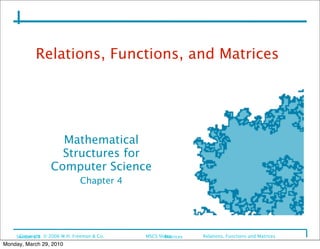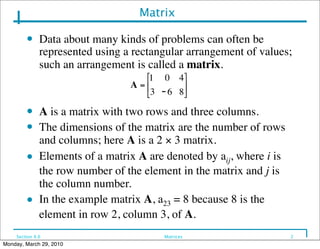CPSC 125 Ch 4 Sec 6
- 1. Relations, Functions, and Matrices Mathematical Structures for Computer Science Chapter 4 Section 4.6 ÂĐ 2006 W.H. Freeman & Co. Copyright MSCS šÝšÝßĢs Matrices Relations, Functions and Matrices Monday, March 29, 2010
- 2. Matrix â Data about many kinds of problems can often be represented using a rectangular arrangement of values; such an arrangement is called a matrix. â A is a matrix with two rows and three columns. â The dimensions of the matrix are the number of rows and columns; here A is a 2 Ã 3 matrix. â Elements of a matrix A are denoted by aij, where i is the row number of the element in the matrix and j is the column number. â In the example matrix A, a23 = 8 because 8 is the element in row 2, column 3, of A. Section 4.6 Matrices 2 Monday, March 29, 2010
- 3. Example: Matrix â The constraints of many problems are represented by the system of linear equations, e.g.: x + y = 70 24x + 14y = 1180 The solution is x = 20, y = 50 (you can easily check that this is a solution). â The matrix A is the matrix of coefïŽcients for this system of linear equations. Section 4.6 Matrices 3 Monday, March 29, 2010
- 4. Matrix â If X = Y, then x = 3, y = 6, z = 2, and w = 0. â We will often be interested in square matrices, in which the number of rows equals the number of columns. â If A is an n à n square matrix, then the elements a11, a22, ... , ann form the main diagonal of the matrix. â If the corresponding elements match when we think of folding the matrix along the main diagonal, then the matrix is symmetric about the main diagonal. â In a symmetric matrix, aij = aji. Section 4.6 Matrices 4 Monday, March 29, 2010
- 5. Matrix Operations â Scalar multiplication calls for multiplying each entry of a matrix by a ïŽxed single number called a scalar. The result is a matrix with the same dimensions as the original matrix. â The result of multiplying matrix A: by the scalar r = 3 is: Section 4.6 Matrices 5 Monday, March 29, 2010
- 6. Matrix Operations â Addition of two matrices A and B is deïŽned only when A and B have the same dimensions; then it is simply a matter of adding the corresponding elements. â Formally, if A and B are both n à m matrices, then C = A + B is an n à m matrix with entries cij = aij + bij: Section 4.6 Matrices 6 Monday, March 29, 2010
- 7. Matrix Operations â Subtraction of matrices is deïŽned by A â B = A + (â l)B â In a zero matrix, all entries are 0. If we add an n à m zero matrix, denoted by 0, to any n à m matrix A, the result is matrix A. We can symbolize this by the matrix equation: 0+A=A â If A and B are n à m matrices and r and s are scalars, the following matrix equations are true: A+B=B+A (A + B) + C = A + (B + C) r(A + B) = rA + rB (r + s)A = rA + sA r(sA) = (rs)A ! ! ! ! rA = Ar Section 4.6 Matrices 7 Monday, March 29, 2010
- 8. Matrix Operations â Matrix multiplication is computed as A times B and denoted as A â B. â Condition required for matrix multiplication: the number of columns in A must equal the number of rows in B. Thus we can compute A â B if A is an n à m matrix and B is an m à p matrix. The result is an n à p matrix. â An entry in row i, column j of A â B is obtained by multiplying elements in row i of A by the corresponding elements in column j of B and adding the results. Formally, A â B = C, where Section 4.6 Matrices 8 Monday, March 29, 2010
- 9. Example: Matrix Multiplication â To ïŽnd A â B = C for the following matrices: â Similarly, doing the same for the other row, C is: Section 4.6 Matrices 9 Monday, March 29, 2010
- 10. Matrix Multiplication â Compute A â B and B â A for the following matrices: â Note that even if A and B have dimensions so that both A â B and B â A are deïŽned, A â B need not equal B â A. Section 4.6 Matrices 10 Monday, March 29, 2010
- 11. Matrix Multiplication â Where A, B, and C are matrices of appropriate dimensions and r and s are scalars, the following matrix equations are true (the notation A (B â C) is shorthand for A â (B â C)): A (B â C) = (A â B) C A (B + C) = A â B + A â C (A + B) C = A â C + B â C rA â sB = (rs)(A â B) â The n à n matrix with 1s along the main diagonal and 0s elsewhere is called the identity matrix, denoted by I. If we multiply I times any nn matrix A, we get A as the result. The equation is: Iâ A=Aâ I=A Section 4.6 Matrices 11 Monday, March 29, 2010
- 12. Matrix Multiplication Algorithm ALGORITHM MatrixMultiplication //computes n à p matrix A â B for n à m matrix A, m à p matrix B //stores result in C for i = 1 to n do for j = 1 to p do C[i, j] = 0 for k =1 to m do C[i, j] = C[i, j] + A[i, k] * B[k, j] end for end for end for write out product matrix C â If A and B are both n à n matrices, then there are Î(n3) multiplications and Î(n3) additions required. Overall complexity is Î(n3) Section 4.6 Matrices 12 Monday, March 29, 2010











![Matrix Multiplication Algorithm
ALGORITHM MatrixMultiplication
//computes n à p matrix A â
B for n à m matrix A, m à p matrix B
//stores result in C
for i = 1 to n do
for j = 1 to p do
C[i, j] = 0
for k =1 to m do
C[i, j] = C[i, j] + A[i, k] * B[k, j]
end for
end for
end for
write out product matrix C
â If A and B are both n à n matrices, then there are Î(n3)
multiplications and Î(n3) additions required. Overall complexity
is Î(n3)
Section 4.6 Matrices 12
Monday, March 29, 2010](https://image.slidesharecdn.com/cpsc125ch4sec6-100329194652-phpapp02/85/CPSC-125-Ch-4-Sec-6-12-320.jpg)